A bench to go with the trestle table in your pub, cottage, or castle. If you're making two or more, do them assembly-line style.
Supplies and tools
- Scale lumber: H0 2×8 for seat and legs, H0 2×3 for stretcher. You'll only use a little bit of the H0 2×8, but you need two pieces that are long enough to get a comfy grip on while shaping them - say 10 cm (4") or more, but not so long that they're unwieldy
- Tacky Glue
- Chopper (or scalpel or X-Acto)

- Needle files - you'll need a three square file and optionally a crossing file (shown in the sketch to the right)
- Sandpaper
Check out the Hints and guides section of the site for additional information about the wood types I use,
as well as hints on cutting and using files and finishing.
Bench
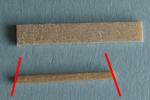
Decide how long you want your bench, mine is 15 mm (5/8"). Cut one seat piece from H0 2×8.
Subtract 3 mm (1/8") from the length of the bench. Cut one piece of H0 2×3 for the stretcher, to this length.
Sand the ends of the stretcher at an angle, as shown by the red lines in this pic.
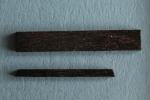
Stain both pieces and put aside to dry.
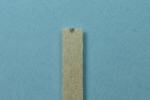
Make sure the end of the two pieces of H0 2×8 is cut straight. Mark the center on one of them.
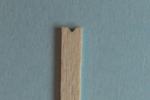
Using the three square file, make a little groove at the mark.
Place the other piece behind it, aligning the edges. Hold them tight, filing with the three square file. (This will give a rather low and wide opening between the legs; if you want it tall and narrow, switch to the crossing file after a few strokes.) Remove the center third or so of the edge (a little more than in this pic). Flip the strips over once in a while (sometimes both together, sometimes one in relation to the other) to make sure they'll be symmetrical.
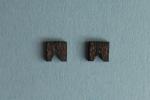
Set the chopper to 2.5 mm (3/32") and cut off the legs, one at a time.
Stain them.
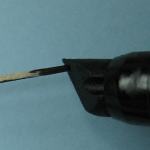
Take a bit of H0 2×3 and check that the end is cut off fairly straight.
Touch your stain marker or stain-loaded brush lightly to the end for a few seconds, letting the stain soak into the wood.
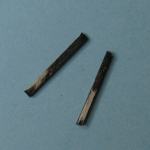
Cut off a piece, something like 1 cm (3/8") for ease of handling.
You only need one piece per bench unless you want extra for spares. Put them aside for now, they'll be cut into tiny pieces for stretcher ends later. (Only part of each piece is usable, as the further away from the end where you applied stain, the less thoroughly stained it'll be. Alternatively, you could cut the minute pieces first and then stain, but that's pretty messy!)
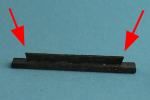
Spread glue on the shortest side of the stretcher and center it on the seat. Check that it looks like in this pic, the arrows showing the slant of the stretcher's ends.
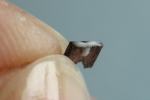
Spread glue on the top edge of one leg, and put a dot of glue right below the center of the edge...
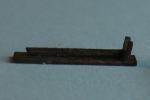
...sticking it in place on the bench. The glue dot is for where the leg meets the stretcher.
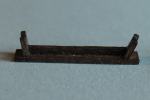
Glue on the other leg too.

IRL, the ends of the stretchers were stuck through holes in the legs and secured with wedges. In this scale it translates to a blob at each stretcher end. To make wooden 'blobs', cut little pieces (two for each bench) from the semi-stained pieces you made earlier.
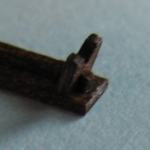
Glue one little wooden bit to the outside of each leg, lining up with the stretcher.
Your bench is finished, set it aside to dry.
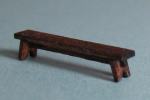
Finally, apply the clear finish.
